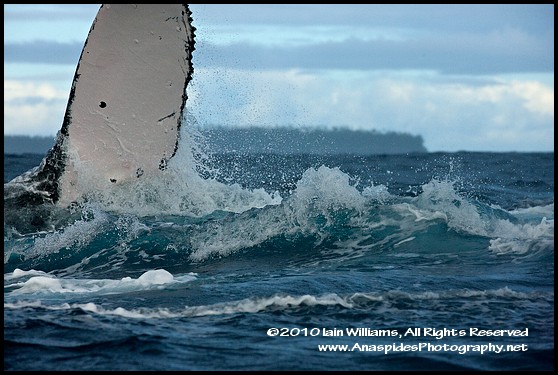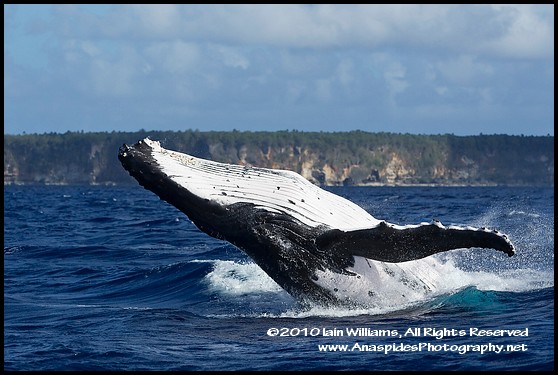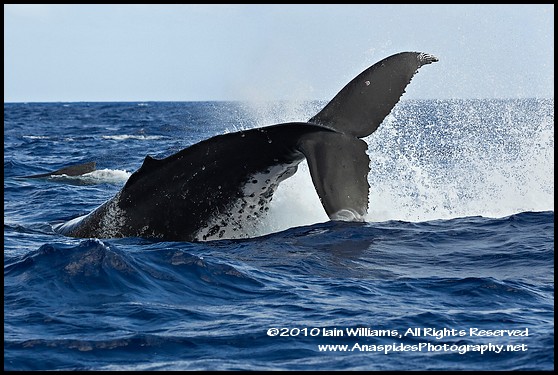Vava'u, Kingdom of Tonga - Tail Slapping Humpback Whales
 Saturday, August 21, 2010 at 9:13AM
Saturday, August 21, 2010 at 9:13AM  Whales are Scarce
Whales are Scarce
Humpback Whales are large air breathing marine mammals. You would have thought it relatively easy to locate such a leviathan, but this wasn’t the case. The islands of Vava'u comprise some 50 islands – many uninhabited and covered in lush vegetation and coconut tree groves. It was in the water surrounding these islands that we began our rather long search, with the score for the first day being whale 1 and photographers nil.
LEFT: A large Humpback Whale shows his tail less than 6 meters from the boat during a "heat run". The whale was so close that I couldn't fit the whole tail in the frame (70 mm).
Finding the whales was to become our nemesis on this trip. Although whale numbers in Vava’u have been steadily increasing each year, the time the whales arrive in Vava’u is slightly different each year; on most years the whales arrive in early July and by August the females have given birth and are suckling their calves in the sheltered water offered by the islands. This year (2010) the whales were late.
We persisted, and spent many hours steaming around the islands, through straights and on a few days steamed 10 kilometres out to sea. Our crew, apart from us, consisted of a Tongan skipper and a first mate – both of who scoured the horizon searching for the tell tail “blow” of a humpback whale. The blow can be seen from many miles away and was used by early whaler’s to discover the location of the whale. We had a slight advantage over the early whalers in that we had a small piece of technology called a hydrophone. By lowering the hydrophone into the water and listening, the presence of a whale could be discovered. Courting males often sing and make chomping noises that provide telltale evidence that a whale is in the area. Interestingly the songs are population specific and change over time with no individual song being identical.
Rough Sea Conditions – Trade Winds
I was very surprised that the sea conditions were not oily calm other than in the lee of islands. The trade winds predominate at this time of year and a 10-15 knot wind is standard issue along with the 1-2 two meter ocean swell and short chop that such a defining wind produces. On some days, it was too rough to venture too far to sea – not so much because of the conditions but more for the comfort of us and the use of our cameras. Getting into the water is rather easy in a rough sea, however, maintaining position in the water for steady filming and getting back on the boat can be problematic.
 Heat Run
Heat Run
Finally, after many hours searching we sight not one blow but several multiple blows. We speed to the location and discover eight fast travelling humpbacks aggressively twirling and rolling around a female. The males aggressively push each other aside as they compete for the favour of the female whale; pectoral fins and tails are used to either hit the water or block an opposing whale. One whale has blood streaming from his head, no doubt caused by the slicing effect of barnacles that attach to the head and nose of humpbacks. The whales continue to interact as we navigate our boat alongside the withering mass of mammal flesh. Several times we are splashed by water as the activity increases in crescendo. One male raises himself above the water to bring his bulk down onto another male thereby allowing access to the female whilst another male raise his tail vertically and slices the water before striking its brethren. Then, as quickly as it began the activity stops and the whales disperse.
Cetacean behaviour is not completely understood, and although aggressive runs between males and females have been termed heat runs, and the behaviour is related to courtship and mating, there is little evidence suggesting that estrous is actually being released by a female whale. Watching such an event is very exciting and it’s at these times that you wish you were shooting video rather than stills.
 Breaching
Breaching
As if the heat run was not enough to please us, as we turned for home we saw several large splashes further out to sea; the whales were breaching and tail slapping. The sea was choppy and as we navigated to the location of the splashes, blue water was rolling up over the windscreen as the boat climbed the crests of waves to fall quickly with a solid bone jarring thump to the bottom of a swell. I thanked myself that my gear was securely packed into a weatherproof pelican case lashed to the rear deck.

Breaching, tail and pectoral slapping are thought to be communication behaviour in which one whale will indicate its position to others in the vicinity. What is for sure, is that this behaviour is very impressive and even more impressive when you see a massive 20 ton whale leap from the water not 20 meters from the boat!
LEFT: Humpback Whale (Megaptera novaeangliae) half breaches beside the boat as we maintain a constant speed with the leviathan. The power unleashed when a humpback whale tail slaps is amzing and can only be appreciated first hand.
Photographing breaching whales in rough seas, as anyone who has done this will attest, is not easy. The process is to keep both eyes open and the camera viewfinder glued to your shooting eye. Once you see a breach you must quickly realign your focal point and take a series of photographs; all to often you are too slow, but with patience and practice it’s possible to record the whale leaping from the water.
Underwater whale photographs to come...



Reader Comments